Wagner cast iron cookware is regarded by many as some of the finest examples of 19th and 20th century cast iron. Much of the cast iron is over 100 years old and still usable today. These antique pans are sought-after by enthusiasts who prefer vintage cast iron to newer pans. But identifying and dating these old Wagner Ware Sidney -o-pans can be tricky.
So, with this article, I hope to help you and other proud owners identify and give an estimate of the age of your cookware. You can also learn the history of your cast iron, which the Wagner Manufacturing Company manufactured.
Table Of Contents
- Wagner cast iron. “Why is it so collectible?”
- Learn the history of the Wagner Manufacturing Company.
- Where you can buy Wagner cast iron.
- Considerations when purchasing Wagner cast iron cookware.
- You can identify and date antique Wagner cast iron using trademarks and logos.
- Final thoughts on collecting vintage Wagner Ware cast iron.
But first, here is a quick look at the Wagner Manufacturing Company.
Identify And Date Your Wagner Cast Iron Skillets Using Logos. Also, Learn The Fascinating History Of Wagner Manufacturing.
Background To Wagner Manufacturing Cast Iron.
Founders | Milton M. Wagner and Bernard P. Wagner |
Operational Dates | The foundry in Sidney operated from 1891-1959 |
Located | The Wagner Manufacturing foundry was in Sidney, Shelby County, Ohio. |
Product Line | Wagner was one of the largest American manufacturers of cast iron products in the 20th century. Their product line included skillets, kettles, bean pots, Dutch Ovens, roasters, fruit presses, scoops, broilers, Griddles, waffle irons, muffin pans, and cornbread pans. The company also had a range of aluminum cookware. |
Wagner Brands | Wagner labeled their cookware under the following names: Wagner, Wagner Ware Sidney -o-, Wagner Ware, National, Long Life, Magnalite, Wardway, and Ward’s Cast Iron. |
Signature Products | Wagner is best known for the Sidney -O- range of skillets and Dutch Ovens. |
Reason For Closure | The reason for the closure of the foundry came from two fronts. Firstly, the Wagner family sold their interests in the company in 1953 to the Randell Company. Secondly, the company struggled financially because of a drop in sales. The decline in sales was due to two World Wars, the Great Depression, the development of new cookware materials, and the increase of lower-priced imports from Asia |
Wagner After Buyout (Non-Collectible) | In 1957, the Randall Company purchased long-term competitor Griswold from McGraw Edison. The Randall Company sold the cast iron businesses to Textron Corp in 1959. General Housewares Corporation bought Textron in 1969. In 1994, the production of Wagner Ware ended. |
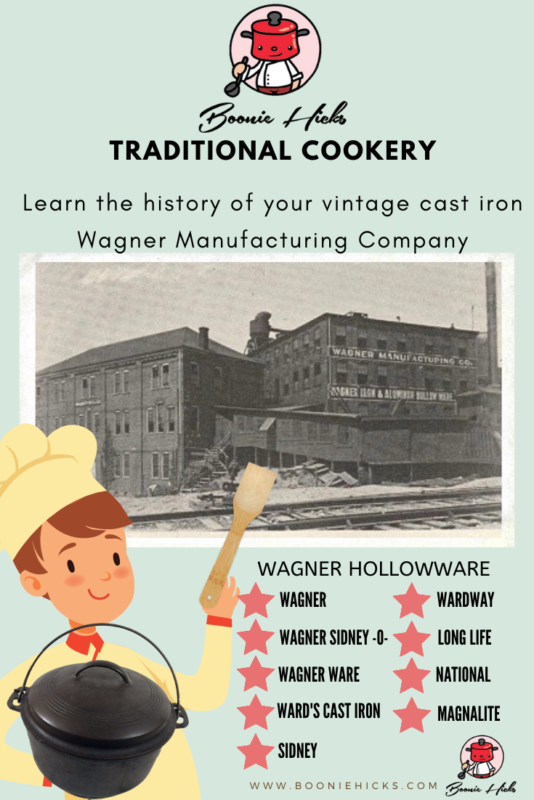
Why Is Wagner Cast Iron Collectible?
Super Smooth Cooking Surface.
Wagner cast iron is highly collectible. Like most antique cast iron, Wagner manufactured high-quality cookware for their entire range of cast iron products.
Unlike Wapak cast iron ironware, it often has characteristic casting flaws. Wagner cast iron tends to have a few casting flaws, resulting in very smooth cookware on both the interior and exterior of the cookware.
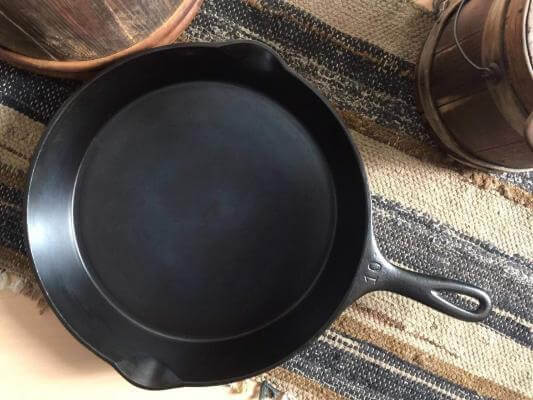
Focus On Quality
Imagine that workers would have worked on individual pieces of ironware. It was machined to smooth the interior and exterior of each pan. You can only see this level of detail in high-end cast iron cookware such as Le Creuset and Staub.
Today, Le Creuset and Staub benefit from combining traditional and modern manufacturing methods. However, the workers at Wagner could make cast iron cookware without casting flaws or bubbles. Must have taken great skill and attention to detail.
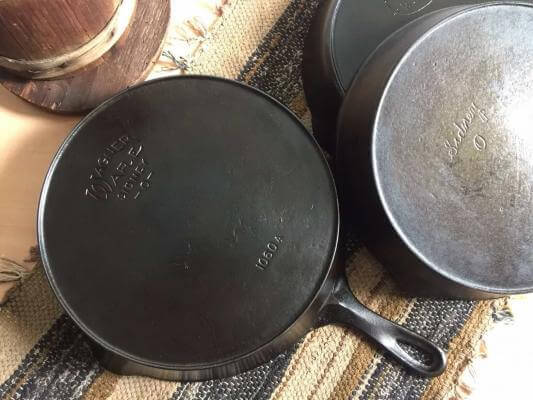
Wagner Made A Wide Range Of Cast Iron Cookware.
You can’t go wrong with an old Wagner cast iron skillet. It will serve you well for years, and they’re great fun. However, you may want to consider a Wagner Dutch oven. They are super smooth, and just like the skillets, they are reasonably priced. You can also buy cast iron muffin pans, which can be pretty cheap. But watch out for shipping costs that can increase the overall price drastically. Some of Wagner cast-iron cookware range includes:
- Dutch ovens
- Griddles
- Gem pans
- Waffle irons
- Skillets
You can even collect Wagner cast iron cornbread pans that look like corn cobs. Wagner Manufacturing also produced aluminum cookware, which must have seemed revolutionary.
Collect Your Favorite Logo.
If you want a vintage skillet, then Wagner skillets are a great choice. You can choose from sixteen different logos and trademarks or markings. I like pans with heat rings, while others may prefer a pan with a smooth base.
I think this wide selection makes Wagner cookware more collectible than other manufacturers, such as Vollrath and Martin Stove and Range, which manufacture a limited range of products.
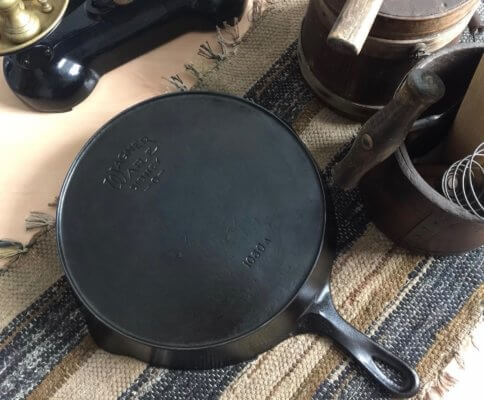
Wagner Manufacturing Company Focused On Quality Over Quantity.
Quality was a focus from the very start for Wagner Manufacturing Company. They even advertised this selling point to consumers. Old advertisements read;
We do not strive to manufacture hollowware as cheaply as possible but as well as it can be made. We cannot afford to put on the market ware that will not sustain our reputation. The name Wagner is on the bottom of each piece of ware.
Wagner Manufacturing Company History
Founders And Foundry
Who Founded Wagner Manufacturing? | Wagner Manufacturing Company was founded in 1891 by Milton M. and Bernard P. Wagner. However, two more Wagner brothers, Louis and William Wagner, joined the company in the following years. Another key player in the foundation of the company was R. Bingham. Bingham previously worked at Marion Stove Company and the Sidney Manufacturing Company. |
Where Was Wagner Cast Iron And Wagner Ware Made? | The company had its ironworks in Sidney, Shelby County, Ohio. Early cookware from Wagner Manufacturing had a simple Wagner marking on the back of the ironware. Wagner included Sidney O. in their cookware around 1895. The term Wagner Ware first appeared in the logo in the 1920s. |
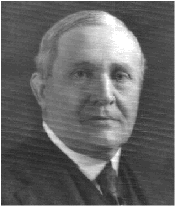
The Wagner Product Line Added Nickel Plating, Aluminum, And Magnalite.
Nickel-Plated Cast Iron | To complement their cast iron range, Wagner added a nickel-plated range. Unlike cast iron and copper pots, nickel plating does not react to acidic foods such as tomatoes, which can taint food. It’s easy to look past the development of nickel-plating. But, in the 19th century, bonding two metals together would have required much metal casting expertise. |
Aluminum Cookware | Along with nickel-plated cast iron, the Wagner brothers in 1894 manufactured a line of aluminum cookware, and Wagner Manufacturing was one of the first companies to do so. |
| Aluminum Cookware Exported To Europe | By 1913, Wagner cast iron and aluminum products were selling in Europe. |
| Magnalite | In the 1930s, Wagner manufactured a cookware line with a patented aluminum alloy called Magnalite. |
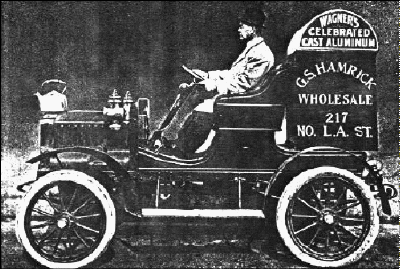
Wagner Manufacturing Buys Their Sidney Competition.
| Wagner Bought Sidney Hollowware Company. | In 1897, Wagner bought the Sidney-based competitor Sidney Hollow Ware Co. from the founder and owner Phillip Smith. Sidney Hollow Ware made high-quality cast iron cookware that was extremely light and smooth. Sidney Hollow Ware Co. was also an early adopter of nickel-plating cast iron. |
Why Did Wagner Buy Sidney Hollow Ware Company? | It was a brilliant idea to buy the Sidney Hollow Ware Company. After all, Wagner Manufacturing and Sidney competed in the same city and made comparable products. However, it was common knowledge that Smith made a tidy profit from his original investment in the foundry. To run the Sidney Foundry, William H. Wagner joined the family business to oversee the operation. |
Wagner Sold Sidney Hollow Ware Back To Phillip Smith. | In 1903, Wagner Manufacturing sold the Sidney Hollow Ware Company to the founder, Phillip Smith. Sadly, Phillip Smith did not reopen the foundry due to health reasons. |
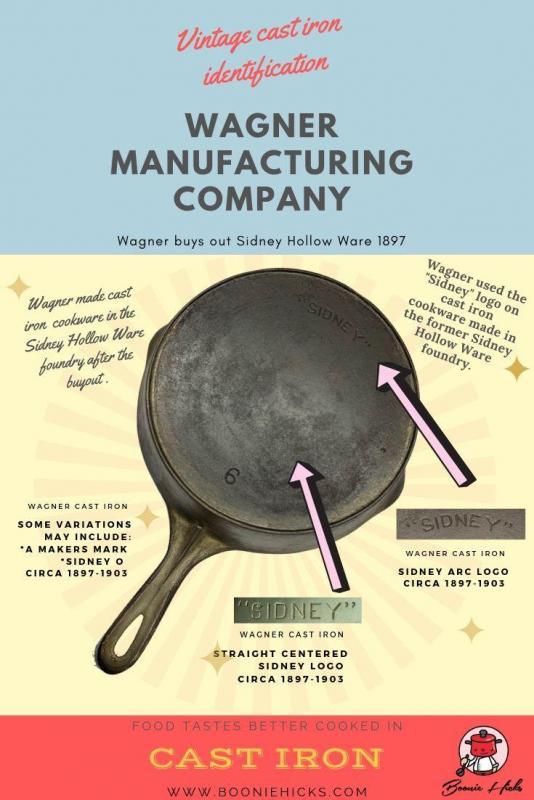
Wagner Introduced A New Product Line To Stop A Decline In Sales.
| The Great Depression (Magnalite) | I have to take my hats off to Wagner because they introduced a new product line called Magnalite in one of the deepest recessions the world has ever seen. Wagner Manufacturing was steadfast in making only quality products. For this reason, the cookware is collected and highly usable. |
| The Sales Decline | Wagner introduced Magnalite to stop falling sales at Wagner Manufacturing; it was not due to their product range. Magnalite was hugely popular, but it could not offset the effect of the worldwide recession. From 1929-1941, the US was in the grips of what we now call the Great Depression. Therefore, it was not only Wagner. However, many foundries struggled financially to survive. Many didn’t. |
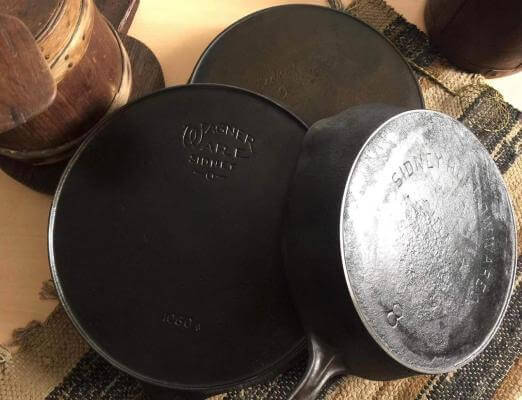
The Family Sells Their Interest In The Foundry.
Wagner Family Sells The Company To Randall Corp. | Wagner Manufacturing Co. lasted longer than many foundries. However, in 1952, Wagner was sold to the Randall Company. Unbelievably, the Randall Company was a car parts manufacturer. |
Textron Buys Randall | In 1959, another business called Tetron bought Wagner. Textron also purchases Griswold Manufacturing Company. At this date, cast iron enthusiasts consider this the end of Wagner Ware production. Wagner cast iron pans made after this date are considered not collectible. |
General House Wares | General Housewares Corporation in 1969 bought the rights of Griswold and Wagner. |
Is Wagner Ware Still Made? | With the world rediscovering cast iron cookware, will we see Wagner Ware skillets manufactured again? General Houses Ware stopped the manufacture of Wagner Ware in 1994. However, there is a glimmer of hope for Wagner Ware. In 2014, American Culinary bought both the Wagner and Griswold trademarks. So, fingers crossed, cast-iron fans may one day decide to manufacture Wagner cast iron again. |
Where Can You Get Your Hands On Some Wagner Ware?
- Grandparents (best deal and great to keep your heritage in the family).
- Antique stores (check online to compare the store price).
- Garage sales (rescue those poor skillets from the tip).
- Flea markets (search the markets for hidden gems).
- Online (largest selection available; however, asking prices can vary greatly.
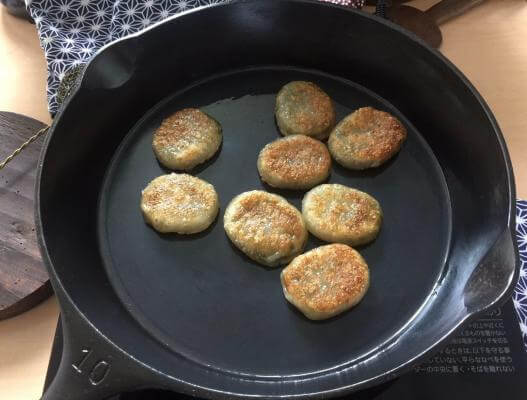
Buying Considerations Before You Buy Antique Wagner Ware
There Is Plenty Of Wagner Cast Iron Around, So Take Your Time.
There is no shortage of Wagner cast iron. Wagner had a large percentage of the cookware market back in its heyday. And plenty of fantastic Wagner skillets and Dutch ovens are in excellent condition.
What Size Skillet Or Dutch Oven Suits Your Needs?
The first thing you may want to think about is the size you need. There are often plenty of #8 skillets around. This size seems to be the most common for Wagner skillets and other vintage cast iron manufacturers, such as Favorite Piqua.
Inspect Carefully Since A Lot Of Wagner Ware Is Nickel-Plated.
Check the cookware carefully. The Wagner Manufacturing Company was an early adopter of nickel plating. However, most of Wagner cookware is unplated iron. Heavy seasoning may hide nickel plating. Nickel-plated can wear off or be patchy in places. Take a close look before purchasing.
Would You Like A Wagner Ware Skillet With A Smooth Bottom Or Heat Ring?
Do you want a pan with a smooth bottom or one with a heat ring? The older Wagner Ware skillets will have a heat ring, while the later-made pans have a smooth, flat base. It is a personal preference. I tend to like the older skillets with heat rings. They have more character, but the smooth-bottom Wagner cookware tends to be a little cheaper. And they are great cooking pans, too.
Does The Cookware Sit Flat?
As with all antique cast iron, asking the seller if the pan sits flat could be a good idea. A lever base is practical if cooking on a flat surface such as induction or glass.
Learn To Date And Identify Your Wagner Cast Iron Using Logos And Markings.
Although I’ve researched carefully, please only use the dates as an approximation.
Wagner cast iron cookware, to my knowledge, has sixteen known logos, brands, or markings. These include:
Straight Wagner Logo 1890s-1915
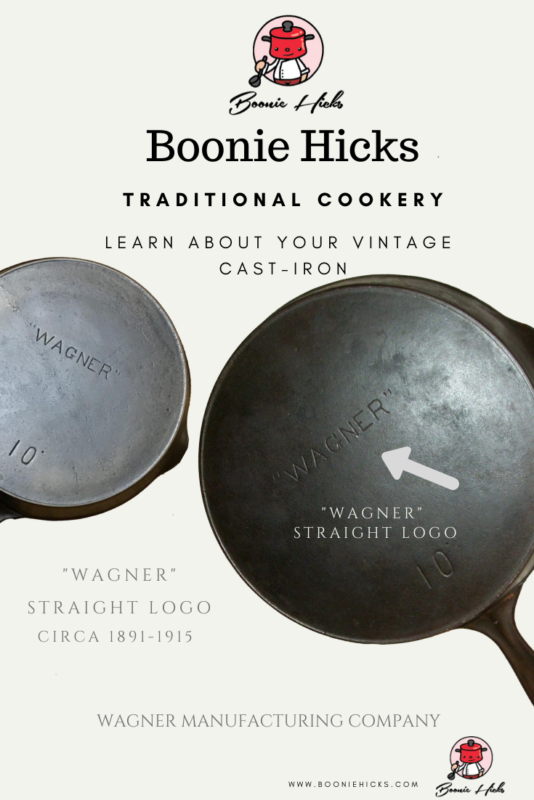
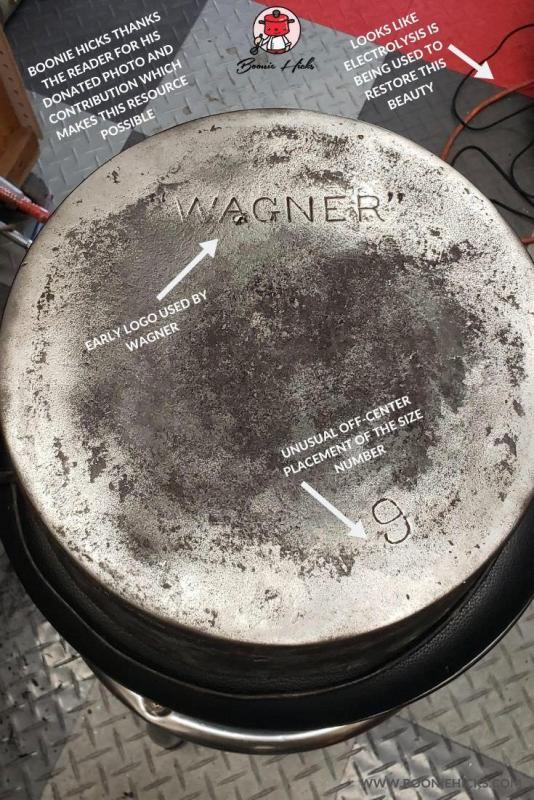
Wagner Arc Logo 1891-1910
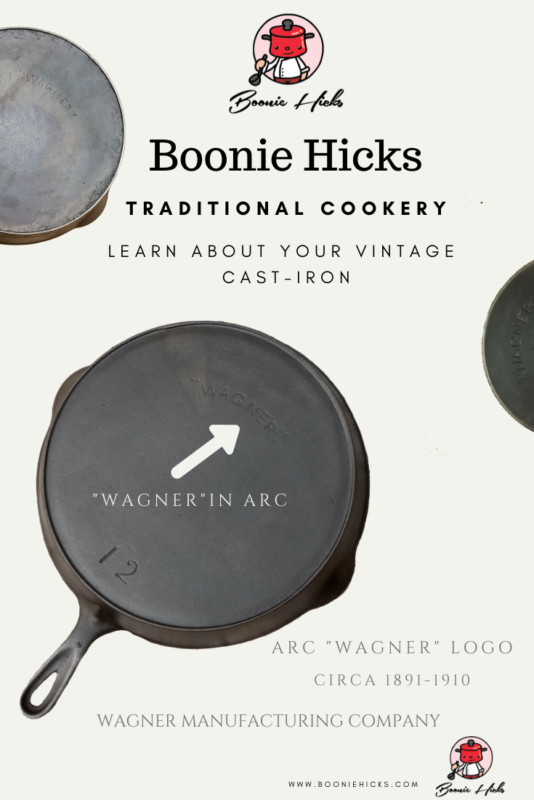

Double Arc Wagner Sidney O 1895-1915
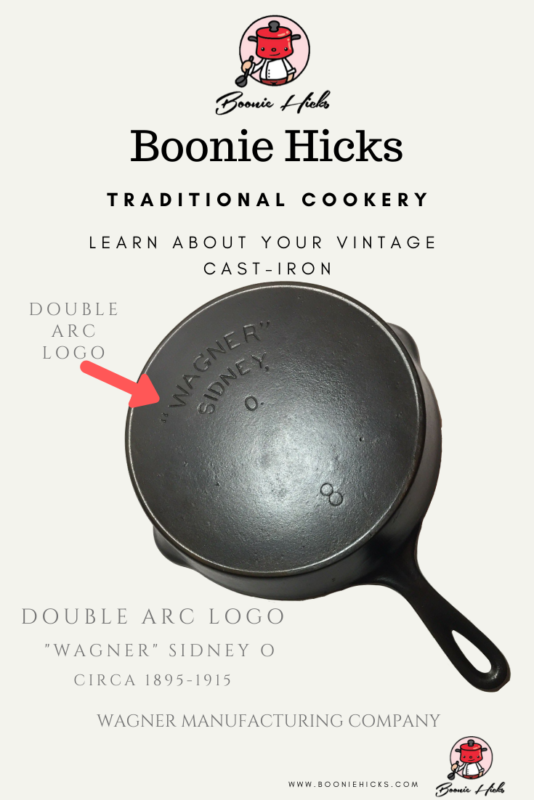
Sidney Arc logo Circa 1897-1903.
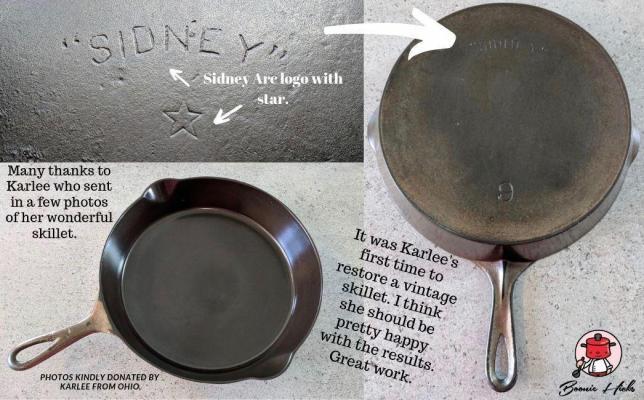
Straight Sidney Logo Circa 1897-1903.
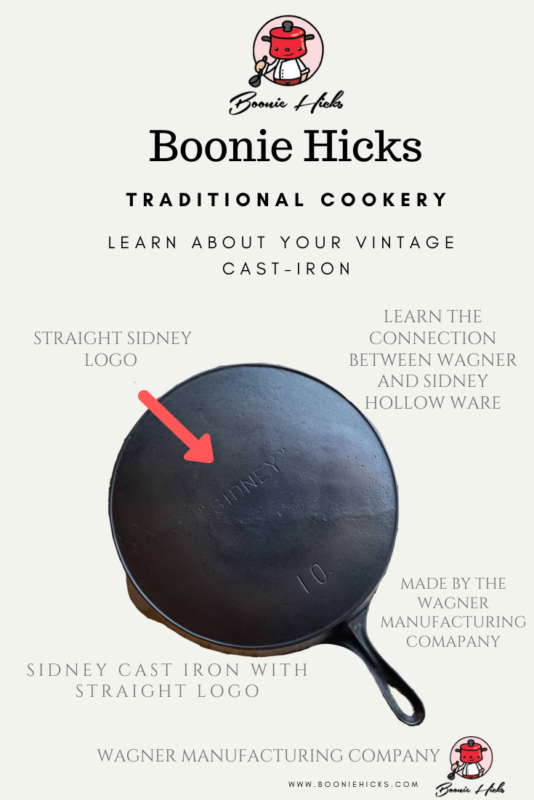
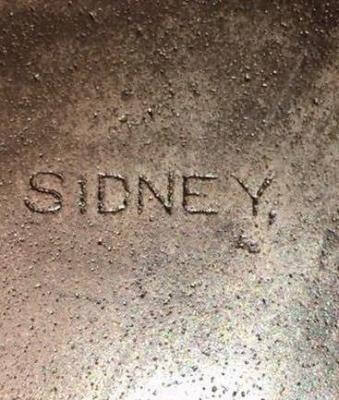
Straight Wagner Sidney O. (Centered.) 1910-1915
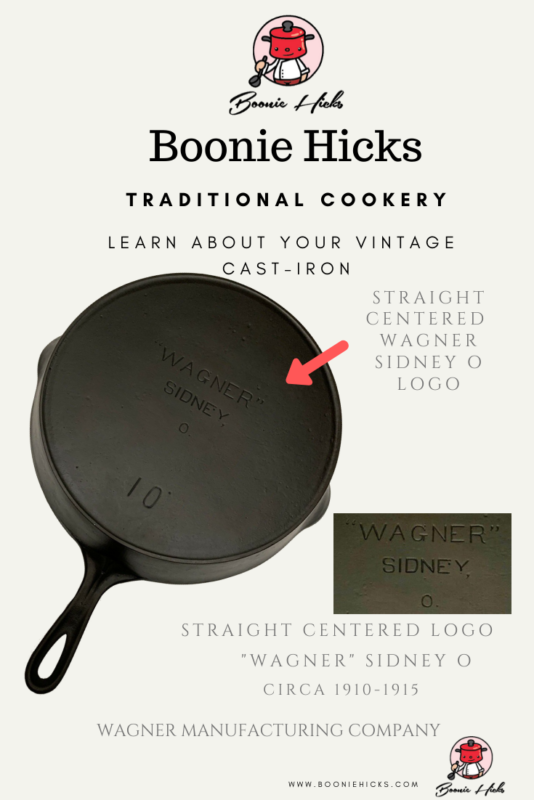
Wagner Sidney O. Wagner Slightly Arced While The Sidney Lettering Is Straight. Circa 1915-1920s
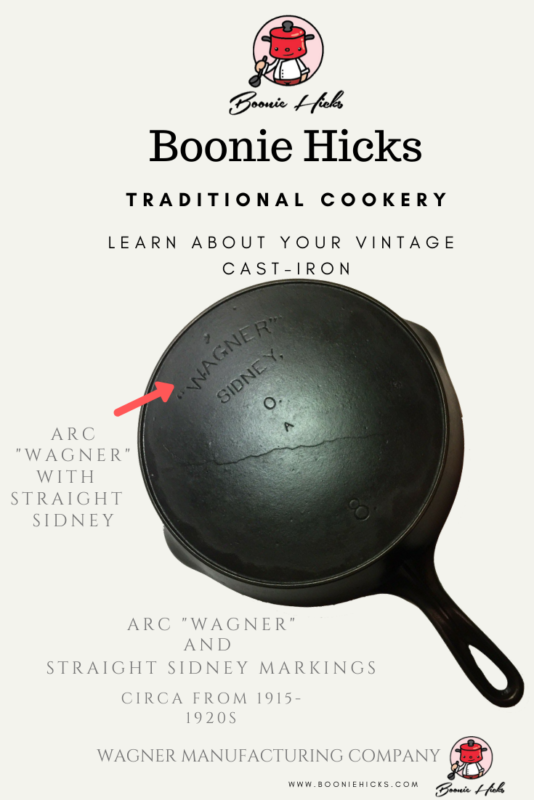
First Wagner Ware Sidney O. With Arc Wagner And Straight Ware And Sidney. Circa 1920s.
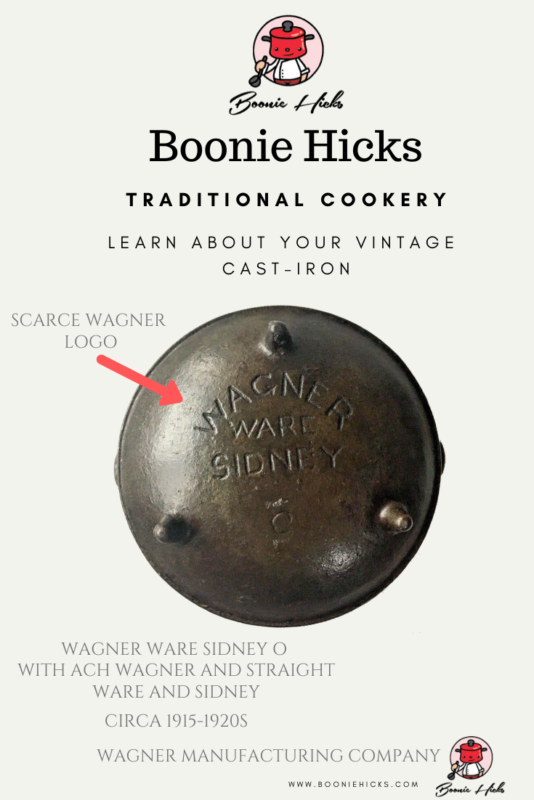
Stylized Wagner Ware Sidney O. for regular skillets. Circa 1920-1924 with heat ring and single-digit size number. 1924-1935 with a heat ring and a four-digit pattern number. Around 1935-1959, for skillets with no heat ring.
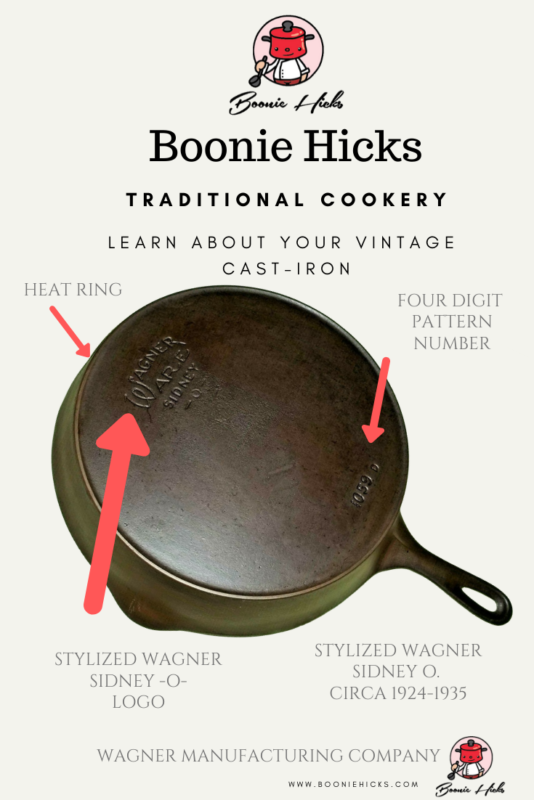
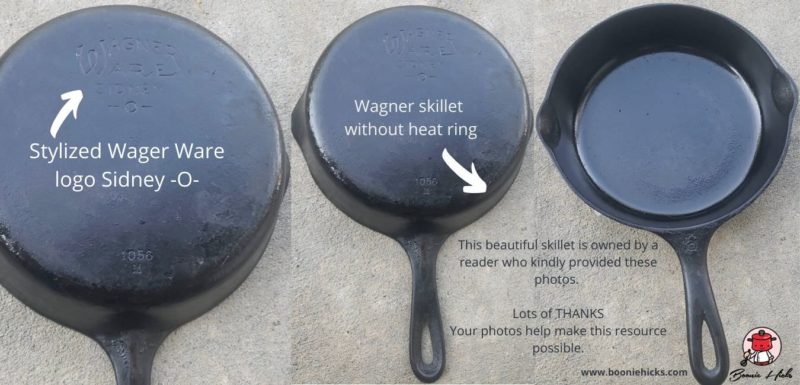
Centralized Stylized Wagner Sidney O. 1924-1935 With Heat Ring.
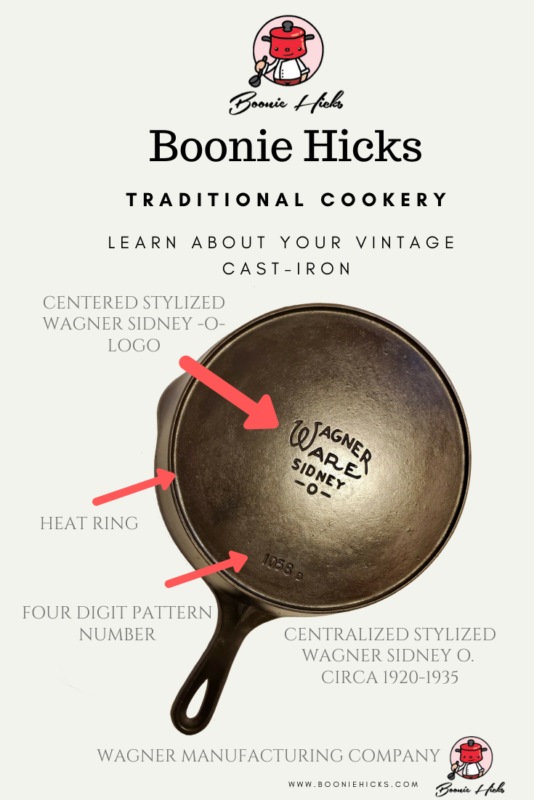
Pie Logo 1924-1934. However, Manufacturing Dates Are Uncertain.
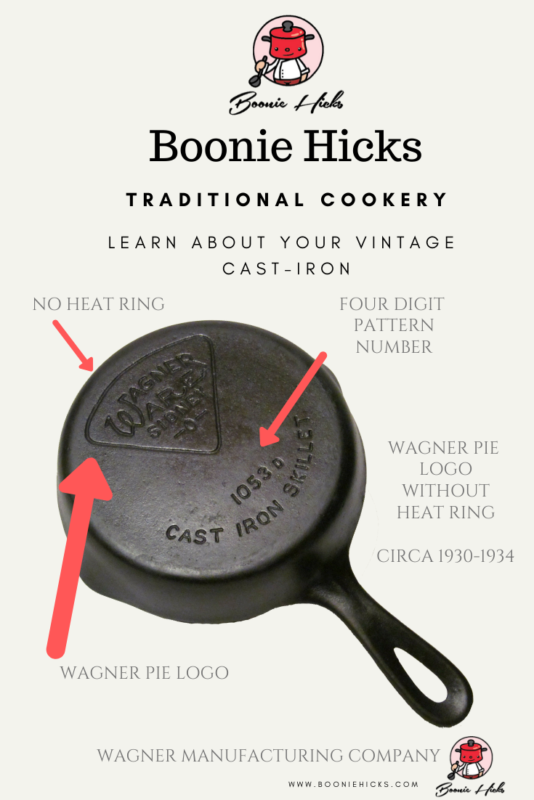
National Cast Iron Dates Between 1914 and 1940s
There are several different versions of cast iron with the National marking. Wanger marketed the Nation brand as entry-level cookware for budget-conscious consumers. Wagner made the National line circa 1914 to 1940.
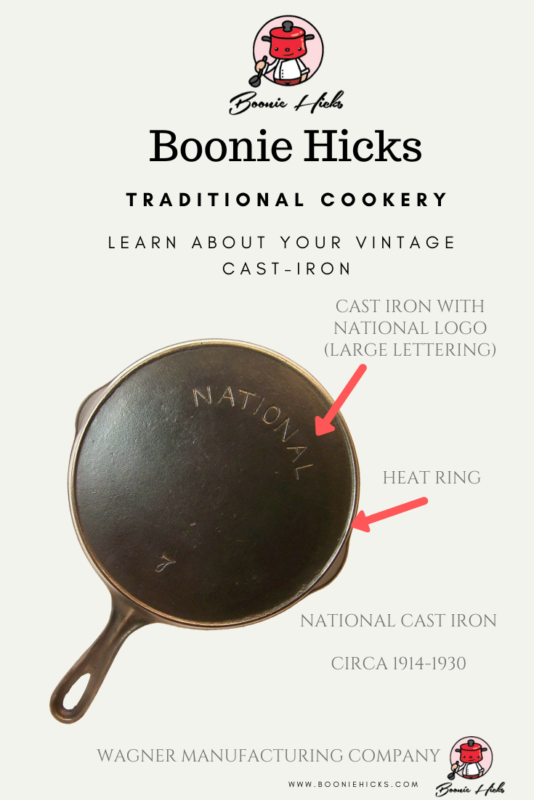
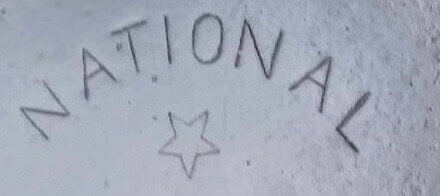
Long Life Logo 1930s.
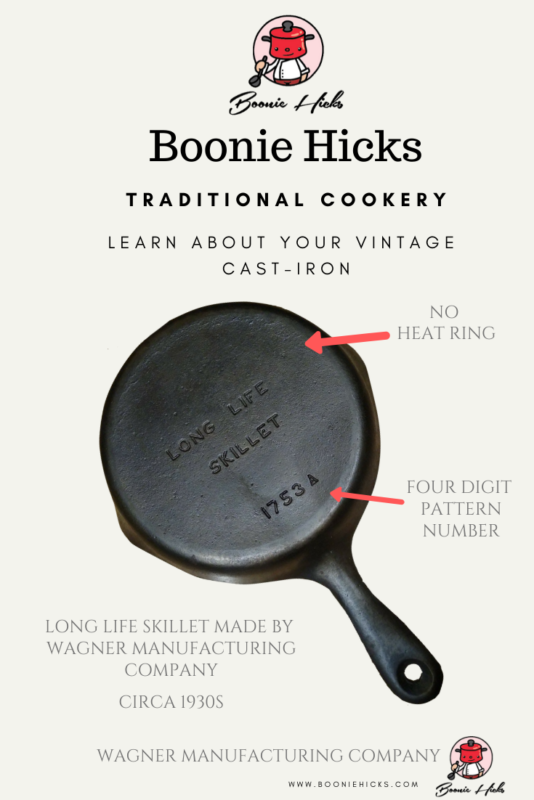
Wardway and Montgomery Ward. The Montgomery Ward Department store contracted Wagner Manufacturing Company to produce an in-store label. Circa the 1930s.
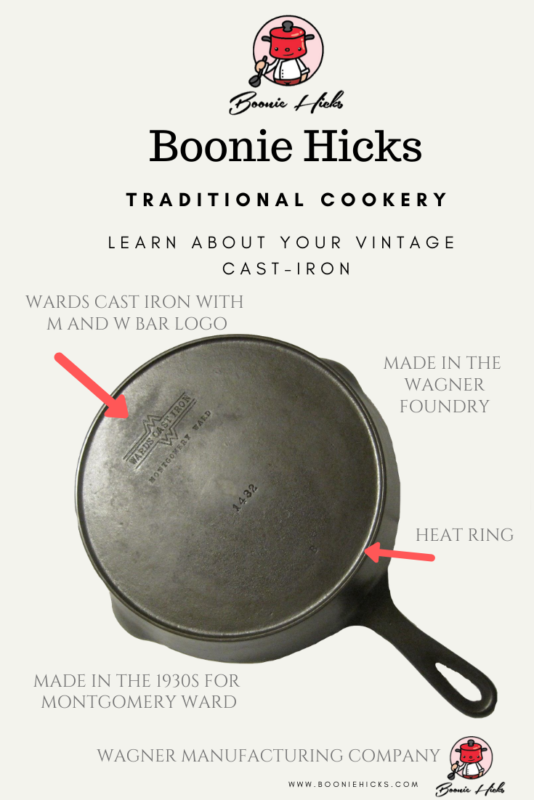
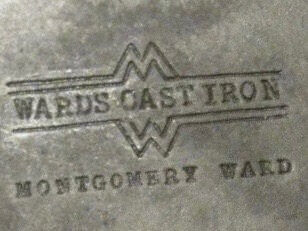
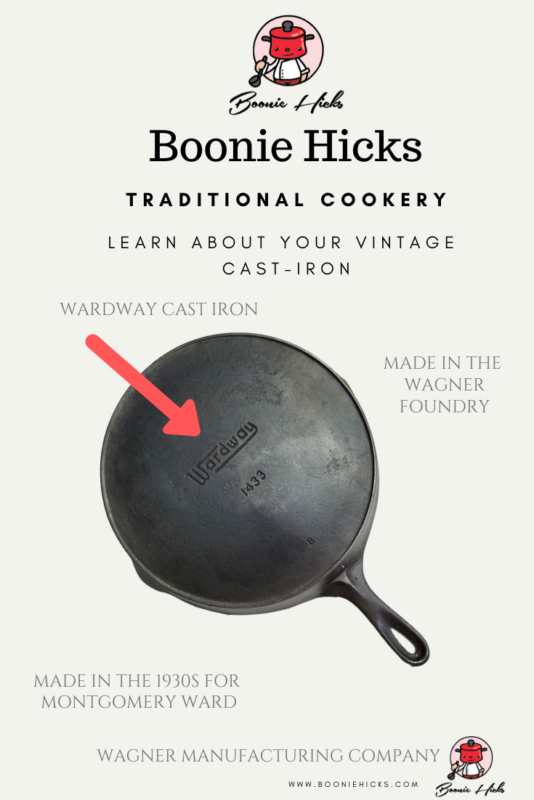
Final Thoughts On Wagner Cast Iron.
Fortunately, Wagner cast iron is more straightforward to date than other foundries of the time. Wagner Ware also has a huge collector base, so dates are well documented. The Cast Iron Collector is a valuable online resource for enthusiasts. Also, there are Facebook groups where you can share your love of cast iron cookware.
The Wagner Manufacturing Company was known for quality over quantity. Therefore, it has a good reputation for making trustworthy products.
Today, collectors and enthusiasts seek out Wagner cookware. However, you don’t need to be a collector to enjoy vintage cast iron. Here are six reasons why Wagner Ware is excellent ironware.
Although many cast iron enthusiasts look for Wagner-made skillets. But you’re not limited there. Wagner Manufactures a wide selection of cast iron cookware. You may find yourself becoming interested in:
- muffin pans
- Dutch ovens
- Scotch bowls
Since Wagner made some of the finest cast iron of the 19th and 20th centuries, Wagner ironware is still sought-after by cast-iron fans and hobbyists alike.

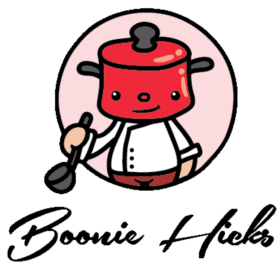
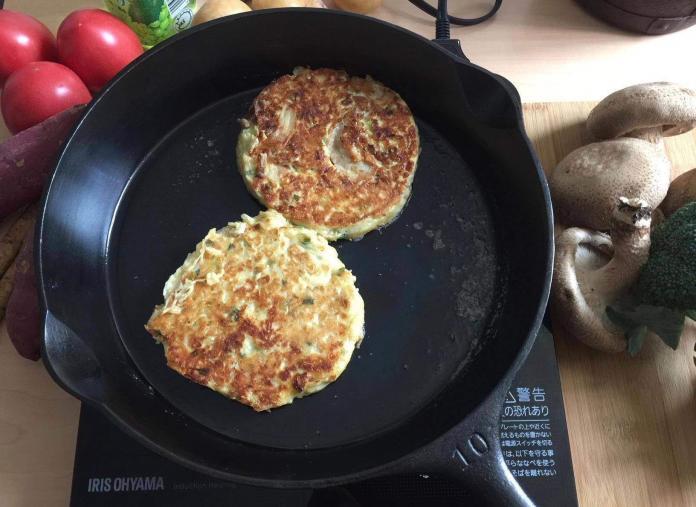
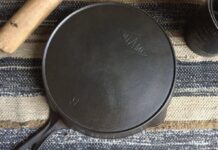
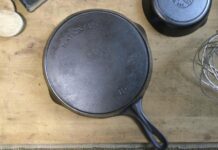
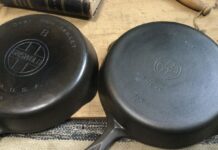



Hi Boonie, I have a Wagner teakettle that I’m researching. Do you know of a resource to help me with that please? It says “Wagner’s 1891 original” on the lid and “original” is in cursive. Below that it says “cast iron cookware” inside a rectangular outline.
I don’t think it’s that old. Does anyone have any insight that might help?
Thank you!
Matt
Hi Matt
Thanks for your question.
You’re spot-on with your estimate on age. Unfortunately, it’s not a vintage Wagner Ware.
Your teakettle was made by General Housewares Corporation in the 1990s. The company made commemorative kettles and other ironware to celebrate 100 years of Wagner cast iron. I’d place your kettle circa 1991-1994. It’s not considered collectible but I’m sure you can make a great cuppa with it nevertheless.
Cheers, hope this helps.
Hi Boonie! (Makes me smile bc my husband’s nickname is Boonie too!)
I enjoyed and appreciate your article and I’m so excited to learn more about cast iron cookware. I received a Wagner Ware Sidney -O- 8 flat bottomed skillet from my Nana before she passed away 15 years ago. I’ve been using it with the outside of the pan encrusted with black stuff! Never bothered me but I’m thinking I may restore it with my newfound knowledge! Unfortunately, it recently got a crack in it, possibly due to extreme temp change by a family member who didn’t consider that. So, it’s now designated for only ”light duty”, like breads. Also, my husband recently brought home 7 pieces of cast iron cookware from his deceased parents’ home, some of them Wagner Ware. His mother definitely used them and some MAY even have been his grandmother’s before that. His mother died 31 yrs ago and these skillets (and 1 Dutch oven) have been stuck, rusting away, in an outside pantry of sorts. I’m so excited to restore these pieces and give one to each of my 7 kids! Have a nice day!
Hi Jan
Thank you so much for getting in touch and sharing the history of your ironware. I’m sure your Nana and your husbands mother are both over the moon that you’re treasuring their old cookware. And it sounds like your getting a lot of enjoyment for these old pieces too. One little crack, I’m sure the old skillet can still cook up a storm.
Restoring these old pieces sounds like a fantastic project.
Cheers, have fun.
Hi. Great article. I have a great Wagner ware 1088 X #8 deep skillet. Could you please tell me if you know it’s nickel plated pan? Thank you.
Hi Maria
Thanks for your question.
I hope you get a lot of use out of your deep skillet. Plated cast iron, including antique ironware is very shiny and will have a silvery appearance. Over the years of use, plating can wear off on the cooking surface. But plating is often in good condition on the exterior of the pan, especially on handle.
However, many people are surprised of the color of bare cast iron. If the color of your Wagner is grey, even shiny grey then I’d say you have regular cast iron.
Hope this points you in the right direction
Hi!
I have a Wagner Ware skillet, not even sure how I got it it’s been that long. It’s a smooth bottom logo having a large “W” which is used as the first letter of Wagner and ware. Logo is positioned at 12 o’clock, at the bottom at 6 o’clock it has “9 inch skillet” beneath that “made in the USA” then below that the letter “F.” The 9 also appears on the handle front. Any clue on the years this could have been made? Thanks so much.
Tom
Hi Tom
Thanks for the contact and detailed description.
I suspect your skillet was made by General Housewares Corporation when they owned the rights of Wagner Ware. Later General Housewares Corporation added their own logo so this can help estimate the age of your skillet. And I think this circa 1970s.
Cheers Tom, I hope this helps and enjoy your skillet.
Hello, I’m watching a Wagner skillet set online. It does have a Sidney -o- at the top of the bottom, the code is 1403. It also has “5 star skillet” mark and the lid can sit on the skillet just like lodge 4-in-1. But I’m worried about the weight due to my antique lodge set. Do you know when it was produced and whether the weight is heavier? When does the cast irons become heavy? I wasn’t able to find any info online. Thank you!
Hi Yifan
Thanks for the question.
Wow a Wagner 5 star skillet set. I believe Wagner made these very early 1940s. And I see Circa 1941 referenced a lot.
You’re right, antique iron was cast thinner than modern ironware but the set would almost be like lifting two skillets. However, I’m sure the seller would be able to give you an exact weight.
Some foundries made skillets with a real heft to them such as Martin Stove and Range. And they were made in the 1940s. But the old Wagners including later made smooth bottom pans are still lighter than modern cast iron.
Cheers, hope this points you in the right direction.
Hello. Not really a question but figure you may enjoy it. Watching YouTube last night and didn’t realize collectability of cast iron. I have my moms old skillets from probably 40s or 50s, not sure of when. A 9″ 1056D with 6 on top of handle and a 11 1/2″ 1060S. Big one is warped in the middle probably because mom was orphaned young and no one taught her how to cook or season pans. Doesn’t bother me because it’s main function is pineapple upside-down cake – none better. After seeing articles, I now plan to restore them both.
Hi Donald
Thanks for getting in touch.
I’m really pleased you’ve decided to restore your pans. It sounds like a perfect weekend project.
Cheers, and good luck with the restoration
Thank you for this very informative information . I have a flat Short edge skillet pan with the curved Warner Sidney logo and 4 digit marking 1109D that was my fathers and I always wondered were he got it. Based on your info, it made between 1924-1935.
However , I have another small skillet with same Warner curved markings and letter C . It’s very worn and looks like its Nickel . Can you tell me when did they made those pans ?
Hi Maria
Thanks I’m really glad you’ve found the resource useful. I’m sure your father is also very happy you’re researching his old skillet. It sounds like an old-timer with a heat ring. Very nice.
Wagner manufactured plated cookware over a number of years but fortunately the date of corresponds with the logo used. Wagner manufactured their regular cast iron range at the same time as their plated cast iron. With a bit of luck you’ll be able to use this resource again to match a logo with the one on your plated skillet.
Cheers hope this helps and enjoy your skillets.
Hi Boonie,
I am stripping and seasoning a skillet that has been in the family possibly more than 60 years. The bottom only says 10 1/2 inch skillet. The handle has a curvy 8 on top and the letter I on the bottom. Is this a late 1950s unmarked Wagner made in Sydney?
Thanks
Hi Carol
It sounds like a great project, I hope you have a nice day for it over there.
Wagner along with a few other foundries manufactured quite a number of unmarked pieces. However, a letter on the back of the handle is strong indication of Wagner made ironware. Check the back of the handle on your skillet. If the handle flattens into a triangular shape where the handle meets the pan then it’s a strong possibility it’s a Wagner and possibly made in the Sidney foundry. If it has a smooth bottom it’s a later skillet and possibly late 1950s, thanks you’ve read my article. Although unmarked skillets are rather hard to date.
Good luck and have fun restoring your skillet.
Cheers
Is there a key to the markings on the bottom of Wagner Ware Sidney Magnalite pans? (especially hoping to find an indication of size)
For instance, an extra large skillet with the markings:
Wagner Ware
-0-
Sidney
Magnalite
4512
Thank you for your help. I appreciate your thorough research and clear explanations in this article.
Hi Lee
Thanks for your question and it’s a good one too. A full list of sizes would require a separate article and lot of research. But It’s a great idea for a future post. Yes there’s an indication of size in the pattern number. Your Magnalite 4512 is a 12 inch skillet that originally came with a lid. However, from my understanding Wagner also made a 8″ and 10″ skillet.
I hope this helps and trust you are getting a lot of enjoyment from your skillet
Cheers, have a good day
Thank you for this great post Boonie!
I have my grandparents cookware, I was raised by them, and thought that was the texture… ugh found it’s a dense layer of carbon. Good thing about it… the pans lack rust!
Two are BSR, but the third was a Sidney -O- 8. If I understand correctly the 1058 B, the B would mean it’s a B mold? Could you tell me if the mold letter means it’s older than say a C, D, or Z?
Thank you in advance. I tried to read as many comments as I could! They are great info, but I worked in these pans (Easy off method) for hours today and I am dragging a bit – so I apologize if I repeated a question.
These pans look so much more amazing now!
Thanks!
From what I see here it would be the ringless post 1935? Because it’s at 12 o’clock and 6 o’clock. Wagner Ware Sidney -O-
I want to get them pretty tbh and use them properly. But I still am curious about their history.
I also have an unidentified Dutch oven with lid and if I recall a trivet! But it’s back home 600 miles away.
Hi there Kelly
You’re spot-on with the date. I’d say Wagner Ware with a smooth bottom was made post 1935. It’s amazing to think it wasn’t that long ago most families cooked on wood ranges. Moving from a wood range to electric must have been so exciting.
Good on ya for restoring your cast iron. Once cleaned vintage cast iron is fun to use and also looks great on display and you’ll be able to share to history of your pans with your visitors.
Have fun restoring your vintage ironware
Hello,
I just inherited my mom’s Wagner Ware 8” skillet with the stylized logo that says Sidney -o- and the number 1058 on the bottom. It does not have a fire ring, can you tell what year this was made and where?
Thank you so much!
Hi Anita
Thanks for getting in touch, and I’m sure your mum is very happy you are researching her vintage skillet.
From your description I can date your number 8 Wagner circa 1935-1959. Your skillet was made in the original Wagner foundry and that was in Sidney, Ohio.
I hope you enjoy using your vintage ironware
Cheers
It’s great your’e looking after and restoring your grandparents cookware. Thanks for reading through the comments section.
You’re right, the letter proceeding the pattern number on regular cast iron skillets was the particular mold used. And 1058 B Wagner Ware was most likely made before a 1058 V skillet with the same design.
Cheers and good on you for restoring your vintage iron, I’m sure your grandparents are smiling and are both so happy that their old cookware is in good hands.
Have a good day
Hello I found a Wagner Ware #7. Drip Drop Roaster. Model #1287 oval 1207 patent. Dec 4_Feb 10_20 mch8_21mch 14_22.
Just want to know how old is it and how to clean it? Any info would help thank you
Hi Christy
Thanks for your question.
Finding an old Wagner Roaster is what I call a good day.
From your description it sounds like you have an older roaster with a marked lid. On the cover I’m guessing there is raised lettering with the words Drip Drop Roaster. In which case I believe your roaster was made in Circa 1920s. So it sure is an old-timer.
Well-done on your find. To clean your oven I’d recommend watching some Youtube videos on how to restore cast iron. For a single piece of cookware I’d recommend the oven cleaning method. But please avoid restoring your roaster with any power tools. As with other antiques this will great reduce the value of your oven.
Cheers, have fun restoring your oven.
Hi – I found a Large #12 Ware Sidney -O- Iron skillet (no heat ring) it also has a 1062A at the bottom. The Ware is in script .
The Sidney is straight not curved. Is it 1930s vintage?
Thanks
Tom Osborne
Hi Tom
Thanks for your question. And I have to say, “great find”. Number 12 is a harder to find size.
From your description it sounds like you have a Wagner Ware with a stylized logo. Because it has a smooth bottom it probably was made Circa 1936-1956.
Enjoy your skillet
Thank you for sharing all of your knowledge and passion for cast iron. I’m a newbie to the cast iron collecting and I’m loving the fact that I can use pieces that are over 100 years old and the continued to get better with every use. Thanks again.
Hi Robin
Thanks for your kind comment and I’m over the moon that you’ve decided to collect and treasure these little pieces of our history. And I feel the same, it’s brilliant we can use these antique everyday. You really are cooking with history.
Cheers, have a good day
I have a Wagner Ware aluminum round roaster with drip drop lid, marked 3248 C. Judging by what I read here, it sounds like 1920’s era. Am I correct?
Hi John
Thanks for your question.
I have little expertise on aluminum cookware but I think you’re really close on the date of manufacture. From my understanding Wagner made these roasters in the 1920s and 1930s.
Cheers John, and enjoy your roaster.
I have a Wagner Ware Sidney -O- Skillet with the word NATIONAL in an arc across the top. The number 1358 at the bottom. I cannot find a size marking anywhere. I’m guessing it’s a #8 based on other cast iron skillets I have. Did Wagner make a skillet without a size marking or has it worn off?
Hi Michael
Wow, Great spotting and it’s not your imagination. Yes, the National, Wagner dual logo is missing the easily identifiable size number at 12 o’clock. As you’ve noticed its replaced by the pattern number. The last digit on National pattern number represents the size.
So you’re right on the money, your trusty skillet is a number 8.
Thanks for the question, hope this helps
I have what I believe to be an unmarked #9 Wagner skillet, with the letter X on the bottom of the pan and back of the handle. I have yet to come across it in my search. Does anyone know anything about this pan?
I have a #8 10-1/2” skillet with the letter “A” on the bottom and handle, and the same question about it.
Hi there Guys
Real sorry it’s taken me a while to respond. However, I think you are both spot-on with your assumption of your pans being a Wagner. Yes, a letter on the back on the handle is a strong indication I would use to identify an unmarked Wagner.
Probably sold cheaper than their marked hollowware but just as finely made.
Enjoy your vintage cast iron
I work with a pet rescue that is totally donation based in how we pay for the care of the dogs we rescue. We have lots of fundraising events, one of them been large garage sales. I had some cast-iron donated that we would like to sell individually instead of in the garage sale where they will not make enough money. I am a novice and collectibles and antiques. Could I send you some photos of them and you tell me how to proceed as far as pricing? They are Wagner mostly, some good health.
Hi Rachel
It’s nice to hear from you and the great work you are providing rescued dogs.
I usually stay away from pricing vintage cast iron, as prices can vary greatly. However, in your case it’s no problem to take a look over your donated collection.
Here’s my email, booniehicks@gmail.com I should be able to date, give a you rough estimate and how to describe your ironware. It would be great if you can include the whole front and back of the cookware. So I can see the cooking surface, handle, logos and markings.
Many thanks and I look forward to your email
Brett a.k.a Boonie
Hi there, I have become very interested in Wagner Ware Oval Roasters recently and have started collecting them. I cam across and purchased a #1 as I have never seen this size before. I have 3,5,7. I once saw a #2 that sold online so I know they exist. I know the #2 is rare, I’m wondering how rare is the #1 ? I have not been able to find much data on them at all. It is a Sytlized logo Wagner Ware Sidney -o- , top says Wagner Drip Drop Baster, handle is the flat folded over version, It has the zig zag pattern on the under side of the lid with the #1 in the middle. Can you share some info on oval roasters for my edification, I would greatly appreciate it !
Hi there Erik
Sorry for my late reply I was traveling around Yamagata and Akita.
I need to do more research on Wagner Oval Roasters. But you’ve probably already come across several different logos and lid designs Wagner used. You have a great collection. To complete a set keep an eye open for sizes 1-9, especially if it sit flat. Trivets are an added bonus and you can expect to pay a little more if it has one along with the bigger sizes. Luckily you already have the #7, nice find.
I have a 10 1/2 made in USA unmarked cast iron skillet I just picked up today at a thrift store. Any way I could send you pics or could you identify what year it’s from please ?
Hi kim
Thanks for the contact and I hope you’re enjoying your vintage pan.
You’re welcome to send a picture or two at booniehicks@gmail.com however, skillets with the markings Made in the USA are generally considered post 1960 era. During this time overseas manufacturers were taking market share from an industry already struggling from the manufacture of modern cookware.
If you want send through a picture that would be great. I’d love to see your purchase.
Cheers, have a good day
Hello Boonie , Trying to identify and date a old number 9 . It has the fire ring , the handle and pour spouts match the Wagners as well as the#”9” matches with Wagners. There is not a Wagner or Sidney stamp but just a star located about where the -o- would be . Any help is appreciated! Thanks Scott
Hi Scott
Thanks for your question.
It sounds like you’re familiar with vintage cast iron with stars often present on Wagner and Sidney cast iron. Stars are frequently seen on National skillets so your skillet could be from the same Era.
Unfortunately, I have not seen a skillet with just the star. But from your description I would also assume it was a Wagner. But you might want to google image search “Erie skillet with star” for a comparison. I wonder if there is a light Erie marking hiding under the seasoning.
This is what makes collecting so interesting.
Thanks for sharing.
I’d love to see a picture if you have time. booniehicks@gmail.com